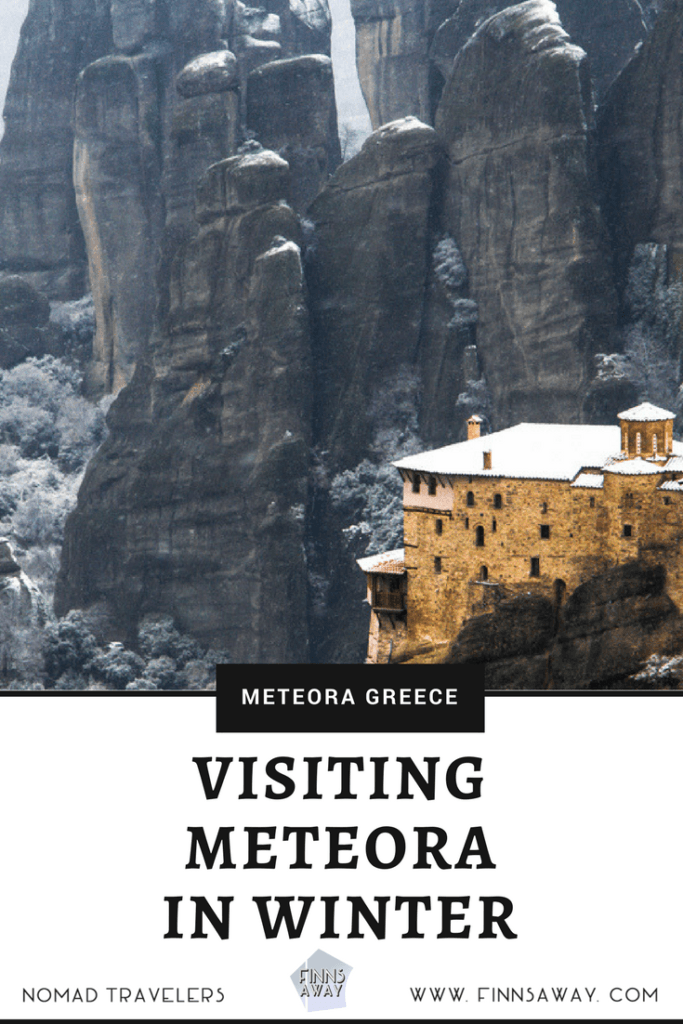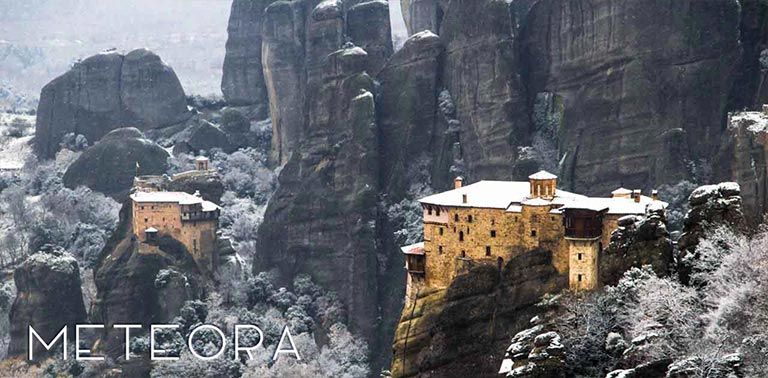
Meteora in winter: rocky wonderland in Greece
Meteora is one of those places that leave a mark in you. Places that open your eyes yet a bit more, and feed the wanderlust in you. Places that remind you that there is so much beauty and nature wonders in the world. This is a story of our visit to Meteora in December 2017.
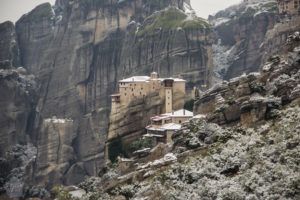 Meteora is a site with exceptional rock formations, in Thessaly region in Central Greece, next to town of Kalabaka (also spelled Kalampaka, Kalambaka). Just the geology of the area, with enormous rock columns, is breath-taking, but in addition to that Meteora is home to several gorgeous Eastern Orthodox monasteries, that are built on top of the towering rocks. You’ll find more pictures of the rocks and monasteries in the gallery)
Meteora is a site with exceptional rock formations, in Thessaly region in Central Greece, next to town of Kalabaka (also spelled Kalampaka, Kalambaka). Just the geology of the area, with enormous rock columns, is breath-taking, but in addition to that Meteora is home to several gorgeous Eastern Orthodox monasteries, that are built on top of the towering rocks. You’ll find more pictures of the rocks and monasteries in the gallery)
The setting of these monasteries, literally on the edge and reaching the skies, makes Meteora a unique sight and one of the most popular tourist attractions in the country. Six of the Meteora monasteries are functioning still today, and can be visited within their opening hours (entrance fee 3 € / each). Meteora is also one of the UNESCO World Heritage Sites in Greece.
Though the most popular time to visit Meteora is in the summer, it’s gorgeous sight any time of the year. To avoid the crowds and hot weather (climbing the stone steps to monasteries and hitting the walking trails can surely be sweaty and tiring during the hottest months), we would recommend to visit outside the peak season. We had the luck to hit the scene after (and during) snowfall just before Christmas, so the landscape turned into snow-covered winter wonderland.
How to visit Meteora
The rocks and monasteries are easily accessible from Kalabaka town or the neighboring, small but charming Kastraki village. Distances in the area are short, so it’s possible to see all the monasteries on a day trip, but the area is so fascinating and photogenic that we warmly recommend reserving at least couple of days for the visit. There are plenty of accommodation options (including camping sites), restaurants, cafes and tour operators in the villages. Kalabaka can be reached by train from Athens or Thessaloniki, or by bus from several bigger cities in Greece mainland. The nearest airport is Volos, about two hours drive away.
The rock formations rise just next to Kalabaka and Kastraki, and there is roughly 10-km long ring road going up to the hills and past all six monasteries. The road offers some awesome views, and there are several viewpoints for photographing and just admiring the scenery. Also, a network of walking paths connect the villages, monasteries, caves and viewpoints. If you are not a fan of trekking and don’t have your own wheels, several tour operators are ready to arrange trips to the monasteries.
For do-it-yourself tours, there is a public bus (operating at least during the high season) driving the ring road few times a day and stopping by the monasteries, and hiring a taxi is a popular option as well. For us it was an easy choice to put on our hiking shoes and simply walk up, and in our opinion it’s also the best way to see the whole area. Compared to hiking through the forest between the rock pillars and to the caves, driving around the area was not nearly as spectacular experience.
Trekking in Meteora
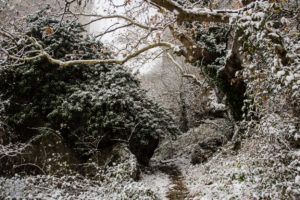 As said, there are several walking tracks in Meteora, leading to the monasteries, caves and viewpoints. Organized walking tours are a big thing, which means that finding the trails and best sites yourself is not too simple. The tracks, except for the official ones, are poorly marked in most of the maps, and there are hardly any signposts pointing the way.
As said, there are several walking tracks in Meteora, leading to the monasteries, caves and viewpoints. Organized walking tours are a big thing, which means that finding the trails and best sites yourself is not too simple. The tracks, except for the official ones, are poorly marked in most of the maps, and there are hardly any signposts pointing the way.
The main trails are easy to walk, but part of the smaller paths are not that well-maintained and rather narrow, including some climbs over rocks. But you should not let that stop you; the area is quite small and it’s not hard to navigate and find your way. If heading to smaller paths, proper trekking shoes are a must, but on the main paths also lighter, but comfortable footwear should be okay. During two days of walking we saw only a handful of other trekkers, so it seems that most of the tourists visiting the monasteries in winter use transportation from one monastery to another, and thus miss part of the views and fun.
Circular walk past four monasteries
We started our first trek from the center of Kalabaka, walking up through the small town, heading towards the Holy Trinity monastery. This is one of the main paths in Meteora area, and even marked with some signposts, and drawn in majority of the free Meteora maps (get your copy form hotels or tourist info). Scenery with fresh snow was beautiful, and quickly we saw the Holy Trinity monastery on top of a rock pillar on the right side of the path. Below the monastery, trekking path meets the official walking route that leads from a ring road parking lot up to the monastery. We hadn’t checked the monastery opening times beforehand, and found out that it was closed that day after climbing up the stairs to the door (opening times of each monastery are clearly marked in the parking lots, but not when approaching via trekking paths). But the climb still wasn’t for nothing, the views are spectacular, and we actually were more interested to see the monasteries in the scenery than from the inside.
From Holy Trinity we walked up to the ring road and along it to Roussanou, Varlaam and Great Meteoron Monasteries. Again we had some bad luck with the opening times, so we didn’t actually visit any of the monasteries the first day. Late afternoon it started to snow heavily, and the rock pillars were wrapped in clouds and mist. We headed down along a path that leads from Varlaam monastery to Kastraki village, and then walked the 2 km back to Kalabaka along road from there.
Visiting the Great Meteoron and exploring Dragon’s Cave
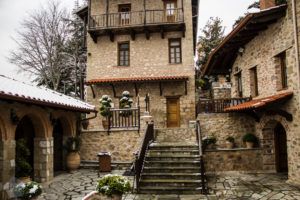 On the second morning the skies were more clear and the scenery even more white than earlier. We hit the trails from the same point in Kalabaka, but turned left towards the rock pillars that rise between Kalabaka and Kastraki, admiring the vertical walls and small caves here and there. We walked along the paths to Roussanou monastery and then again along the road to Great Meteoron, the oldest and biggest of the Meteora monasteries. This time the doors were open, and we explored this magnificent place also from the inside; cathedral with frescoes, small museums and awesome views towards other monasteries.
On the second morning the skies were more clear and the scenery even more white than earlier. We hit the trails from the same point in Kalabaka, but turned left towards the rock pillars that rise between Kalabaka and Kastraki, admiring the vertical walls and small caves here and there. We walked along the paths to Roussanou monastery and then again along the road to Great Meteoron, the oldest and biggest of the Meteora monasteries. This time the doors were open, and we explored this magnificent place also from the inside; cathedral with frescoes, small museums and awesome views towards other monasteries.
On our way down along the path from Great Meteora we found an entrance to a cave at the foot of the rock pillar that carries the Varlaam monastery. This huge cave, that goes through the rock pillar, is called the Dragon’s Cave. According to an old legend, once upon a time a dragon used to live in the cave and feed with the villagers and their livestock. Story tells that to help the people, a monk living up in Varlaam finally cursed the dragon and sacrificed himself by jumping of the cliff, after which the roof of the cave partially collapsed, killing the dragon. The cave is still there though, and it’s fascinating place to explore.
What else to see and do in Meteora
- On top of the six functioning monasteries, there are several ruined, old monasteries still left in the area. Surely you could find a way to trek to see some of them, and there are bunch of tours available also.
- It is no wonder that rock climbing is a popular sport in Meteora, the rock formations offer awesome setting for that, and there are hundreds of climbing routes on the rock towers and cave walls.
- If you have more time to enjoy Meteora and surroundings, the organized tours include other outdoor activities like mountain biking and rafting, and indoor experiences like museum tours and food and wine tours.
- When focusing on the rocks and monasteries, many visitors forget to explore the Kalambaka town and Kastraki village. Reserve some time for just walking around these picturesque towns, visit the pretty churches, pet the cute dogs that meander on the streets and have something to eat of drink in one of the small restaurants.
Where to stay in Meteora
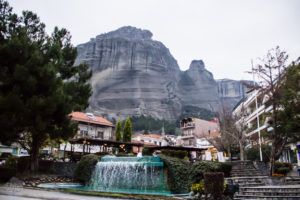 Since Meteora stone valley is such a popular tourist destination, there is plenty of accommodation options available from camping grounds to hotels. Still, booking well ahead is recommended, especially during summer season and public holidays. We visited just before Christmas, and most of the inexpensive accommodation options were booked already, and part of Airbnb apartments were not available at all in the winter. So we had to exceed our “normal” accommodation budget a bit, but got really nice room from Galaxy Hotel in Kalabaka with 36 € per night, including breakfast buffet. Both Kalabaka and Kastraki are nice places to stay, Kastraki being quieter and a bit closer to most of the monasteries, when Kalabaka has more options for eating out, and even some nightlife.
Since Meteora stone valley is such a popular tourist destination, there is plenty of accommodation options available from camping grounds to hotels. Still, booking well ahead is recommended, especially during summer season and public holidays. We visited just before Christmas, and most of the inexpensive accommodation options were booked already, and part of Airbnb apartments were not available at all in the winter. So we had to exceed our “normal” accommodation budget a bit, but got really nice room from Galaxy Hotel in Kalabaka with 36 € per night, including breakfast buffet. Both Kalabaka and Kastraki are nice places to stay, Kastraki being quieter and a bit closer to most of the monasteries, when Kalabaka has more options for eating out, and even some nightlife.
About geology and history of Meteora
- The majestic rock columns are mixture of sandstone and conglomerate, that was formed over millions of years by streams flowing into delta area.
- According to scientist’s theories, roughly 60 million years ago earth movements pushed the land up, creating a high plateau with vertical fault lines.
- Weathering by high winds, waves and temperature changes formed the rock pillars and caves in them over the ages.
- Caves in Meteora were inhabited already 50 000 years ago. Monks occupied some caves in the area during 9th century.
- First ascetic state and a church was established in 12th century, and in early 14th century the first monastery was founded on a huge rock. It was named Meteoro, meaning “suspended in the air” or “hanging from nowhere”. The Great Meteoron Monastery was quickly followed by more than 20 other monasteries.
- Rock tops as a building place offered not just peaceful and sacred site for living and meditating, but safe shelter from Turkish attacks in Greece. The only ways to enter the monasteries were removable ladders or windlasses.
- Six of the Meteora monasteries are still functioning today, partly open to visitors and holding interesting museums.
List of Meteora Monasteries
Holy Monastery of St. Stephen (Stefanos)
This monastery is easily accessed from the road along a stone bridge, so suitable also for those who can’t walk up steep steps. First evidence from the site is already from late 12th century, and the monastery was founded on 14th century. It has been nunnery since 1961, and 28 nuns live in the monastery today.
Holy Monastery of the Holy Trinity
Holy Trinity monastery is imposingly situated on a massive rock and as well as most of the other monasteries, it was for long only accessible with long rope-ladders and nets. There is a Byzantine style church that dates back to 1475. Just 4 monks live in the monastery nowadays.
Holy Monastery of Rousanou
Rousanou is situated on a narrow and steep rock, and the current form was built on 16th century. The katholikon in the monastery is dedicated to the Transfiguration of Christ and is home to remarkable frescoes. It was originally a monk monastery, later turned to nunnery, and the present community of nuns has lived there since 1988, with 13 nuns nowadays.
Holy Monastery of Varlaam
Varlaam was founded in mid 14th century and includes a museum and wooden Chapel of the Three Bishops. It is home to an impressive collection of manuscripts, frescoes and icons. Today 7 monks live in Varlaam Monastery.
Holy Monastery of Great Meteoron
Also called the Holy Monastery of the Transfiguration of Jesus. The oldest and biggest of the monasteries was founded on a huge rock around 1340. It’s home to rich collection of frescoes, a museum of manuscripts and a remarkable monastery library.
Holy Monastery of St. Nicholas Anapausas
This monastery closest to Kastraki was founded in early to mid 14th century. It sits atop of narrow rock, so in a very limited surface, and thus is built in several floors. In chapel of Saint Antony are some remains of 14th century frescoes. Today it is home to only one monk, abbot archimandrite Polykarpos Venetis.
When visiting the monasteries, remember to dress properly, covering legs and shoulders. In part of the monasteries women should wear a long skirt, but it is also possible to borrow a wrap from the entrance to be used as a skirt.
Meteora on screen
You haven’t visited Meteora but the scenery looks weirdly familiar? Fan of Game of Thrones? Well then you probably have seen it in the famous series. Scenery from Meteora was used as a setting for Eyrie, the castle in the sky. Meteora rock towers were the view from the sky cell where Tyrion was held as prisoner. Due to strict protection of the site, actual scenes were not filmed in Meteora though, but it was digitally mastered into the scenes about Eyrie. Also James Bond has struggled in Meteora, in the movie For Your Eyes Only.

